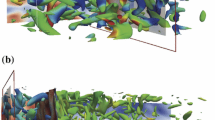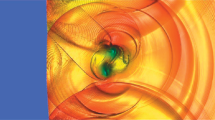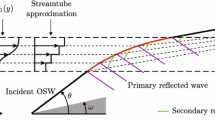Abstract
The wall interaction of isolated compressible vortices generated from a short driver section shock tube has been simulated numerically by solving the Navier–Stokes equations in axisymmetric form. The dynamics of shock-free (incident shock Mach number \(M = 1.36\)) and shock-embedded \((M = 1.57)\) compressible vortices near the wall has been studied in detail. The AUSM+ scheme with a fifth-order upwind interpolation formula is used for the convective fluxes. Time integration is performed using a low dissipative and dispersive fourth-order six-stage Runge–Kutta scheme. The evolution of primary and wall vortices has been shown using the velocity field, vorticity field, and numerical schlierens. The vortex impingement, shocklets, wall vortices, and their lift-off are clearly identified from the wall pressure time history. It has been observed that the maximum vorticity of the wall vortices reaches close to 30 % of the primary vortex for \(M = 1.36\) and it reaches up to 60 % for \(M = 1.57\). The net pressure force on the wall due to incident shock impingement is dominant compared to the compressible vortex impingement and their evolution.


















Similar content being viewed by others
Abbreviations
- M :
-
Mach number of the incident shock
- t :
-
Time; \(t = 0\) represents incident shock at shock tube exit
- D :
-
Inner diameter of the shock tube (64 mm)
- x :
-
Distance from the shock tube exit to wall (300 mm)
- y :
-
Perpendicular distance from the symmetry line
- PR :
-
Pressure ratio between the driver and driven sections
- CRVR:
-
Counter rotating vortex ring
- R :
-
Radius of the computational domain (640 mm)
References
Hornung, H., Elsenaar, A.: Detailed measurements in the transonic vertical flow over a delta wing. Fluid Dyn. Res. 3, 381–386 (1988)
Schiavetta, L.A., Boelens, O.J., Crippa, S., Cummings, R.M., Fritz, W., Badcock, K.J.: Shock effects on delta wing vortex breakdown. J. Aircr. 46(3), 903–914 (2009)
Elder, F.K., Hass, N.: Experimental study of the formation of a vortex ring at the open end of a cylindrical shock tube. J. Appl. Phys. 23, 1065–1069 (1952)
Minota, T., Nishida, M., Lee, M.G.: Shock formation by compressible vortex ring impinging on a wall. Fluid Dyn. Res. 21, 139–157 (1997)
Kontis, K., An, R., Edwards, J.A.: Compressible vortex ring studies with a number of generic body configurations. AIAA J. 44, 2962–2978 (2006)
Kontis, K., An, R., Zare-Behtash, H., Kounadis, D.: Head-on collision of shock wave induced vortices with solid and perforated walls. Phys. Fluids 20, 016104 (2008)
Murugan, T., Das, D.: Characteristics of counter-rotating vortex rings formed ahead of a compressible vortex ring. Exp. Fluids 49, 1247–1261 (2010)
Murugan, T., Das, D., Jain, M.: On the collision of compressible vortex ring with wall. J. Vis. 11, 277 (2008)
Murugan, T., Das, D.: Experimental study on a compressible vortex ring in collision with a wall. J. Vis. 15, 321–332 (2012)
Mariani, R., Kontis, K., Gongora-Orozco, N.: Head on collisions of compressible vortex rings on a smooth solid surface: effects of surface distance variation. Shock Waves 23, 381–398 (2013)
Mariani, R., Quinn, M.K., Kontis, K., Marraffa, L.: Shock-free compressible vortex rings impinging on a stationary surface: effects of surface angle variation. Exp. Therm. Fluid Sci. 47, 126–142 (2013)
Liou, M.-S.: A sequel to AUSM: AUSM+, 1996. J. Comput. Phys. 129, 364–382 (1996)
Murugan, T., De, S., Dora, C.L., Das, D.: Numerical simulation and PIV study of compressible vortex ring evolution. Shock Waves 22(1), 69–83 (2012)
Dora, C.L., Murugan, T., De, S., Das, D.: Role of slipstream instability in formation of counter rotating vortex rings ahead of a compressible vortex ring. J. Fluid Mech. 753, 29–48 (2014)
Ishii, R., Fujimoto, H., Hatta, N., Umeda, Y.: Experimental and numerical analysis of circular pulse jets. J. Fluid Mech. 392, 129–153 (1999)
Arakeri, J.H., Das, D., Krothapalli, A., Lourenco, L.: Vortex ring formation at the open end of a shock tube: a PIV study. Phys. Fluids 30, 1008–1019 (2004)
Murugan, T., De, S., Dora, C.L., Das, D., Prem Kumar, P.: A study of the counter rotating vortex rings interacting with the primary vortex ring in shock tube generated flows. Fluid Dyn. Res. 45, 025506 (2013)
De, S., Murugan, T.: Numerical simulation of shock tube generated vortex: effect of numerics. Int. J. Comput. Fluid Dyn. 25(6), 345–354 (2011)
Calvo, M., Franco, J.M., Rández, L.: A new minimum storage Runge–Kutta scheme for computational acoustics. J. Comput. Phys. 201, 1–12 (2004)
Kim, K.H., Kim, C.: Accurate, efficient and monotonic numerical methods for multi-dimensional compressible flows. Part II: multi-dimensional limiting process. J. Comput. Phys. 208, 570–615 (2005)
Drikakis, D.: Advances in turbulent flow computations using high resolution methods. Prog. Aerosp. Sci. 39, 405–424 (2003)
Hahn, M., Drikakis, D.: Assessment of large eddy simulation of internal separated flows. J. Fluids Eng. 371(7), 071201 (2009)
Poinsot, P.J., Lele, S.K.: Boundary conditions for direct simulations of compressible viscous flows. J. Comput. Phys. 101, 104–129 (1992)
Sun, M., Takayama, K.: A note on numerical simulation of vortical structures in shock diffraction. Shock Waves 13, 25–32 (2003)
Chen, Z., Yi, S.H., Tian, L.F., He, L., Zhu, Y.Z.: Flow visualization of supersonic laminar flow over a backward-facing step via NPLS. Shock Waves 23, 299–306 (2013)
Murugan, T., Das, D.: On evolution and acoustic characteristics of compressible vortex ring. Int. J. Aeroacoust. 7, 199–222 (2008)
Halder, P., De, S., Sinhamahapatra, K.P., Singh, N.: Numerical simulation of shock–vortex interaction in Schardin’s problem. Shock Waves 23, 495–504 (2013)
Murugan, T.: Flow and acoustic characteristics of high mach number vortex rings during evolution and wall-interaction: an experimental investigation. Ph.D. Thesis, Indian Institute of Technology, Kanpur (2008)
Murugan, T., Das, D.: Characteristics of counter-rotating vortex rings formed ahead of a compressible vortex ring. Exp. Fluids 49, 1247–1261 (2010)
Sun, M., Takayama, K.: Vorticity production in shock diffraction. J. Fluid Mech. 478, 237–256 (2003)
Brouillette, M., Hebert, C.: Propagation and interaction of shock generated vortices. Fluid Dyn. Res. 21, 159–169 (1997)
Naitoh, T., Banno, O., Yamada, H.: Longitudinal vortex structure in the flow field produced by a vortex ring impinging on a flat plate. Fluid Dyn. Res. 28, 61–74 (2001)
Obermeier, F.: On a new representation of aeroacoustics representation of aeroacoustic source distribution. I. General theory. Acustica 42, 56–61 (1979)
Acknowledgments
The authors gratefully acknowledge their access to the High Performance Computing Facility at CSIR-CMERI, Durgapur, for providing the necessary computational resources. The authors would like to thank the reviewers for their valuable comments to enhance the quality of the paper.
Author information
Authors and Affiliations
Corresponding author
Additional information
Communicated by F. Lu and A. Higgins.
Rights and permissions
About this article
Cite this article
Murugan, T., De, S., Sreevatsa, A. et al. Numerical simulation of a compressible vortex–wall interaction. Shock Waves 26, 311–326 (2016). https://doi.org/10.1007/s00193-015-0611-2
Received:
Revised:
Accepted:
Published:
Issue Date:
DOI: https://doi.org/10.1007/s00193-015-0611-2




